4th December 2007
 Tuesday, December 4, 2007 at 10:06PM
Tuesday, December 4, 2007 at 10:06PM
Sure enough, the huge monster crocodiles were there. We set out to find them at 7.30am, so we could spend an hour or so watching them before work. We didn’t even have to go as far as the falls on the Mtito River before we found the first ones. As we walked from the house upstream, we started seeing them lying on sandbanks, or heading up the rapids towards the falls. Mostly, we just got brief glimpses before they sensed us and slid into the water. Trying to approach crocodiles unnoticed is difficult at the best of times, for their senses are so highly attuned. If they don’t see you or hear you, they smell you coming and slither back into the water, where even the largest ones miraculously vanish from view altogether (amazing how such a huge and ancient predator is so affected by the human scent).

View from cliff-top (click to enlarge)
This morning the wind was not strong but it was swirling, which made it extremely difficult to get to our vantage cliff without disturbing the crocodiles. We found three huge ones at the place where they seem to know the fish always congregate, in the pool at the base of one of the falls. The largest of these three monsters was like a dinosaur: huge and black and prehistoric, lying there with his mouth open in the flowing water, just waiting for the fish to fall right in.
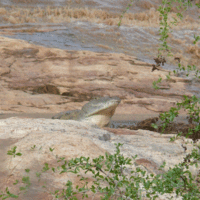
Creepin' up on crocs ain't easy!
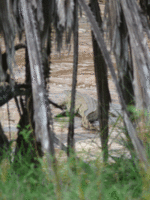
Look behind the doum palm fronds...
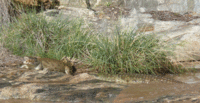
Two monsters... (click any image to enlarge)

A dinosaur lies in wait...
At 5pm, we escaped the office and were straight back with the crocodiles, which were all still where we had left them, and a few more besides. At last light, I photographed yet another crocodile (this time a small one) moving upstream over one set of falls, and onto the next – it won’t go too much further though, for it knows that if it reaches the pool where the monsters are lurking, its days will be numbered, for big crocodiles eat little crocodiles.
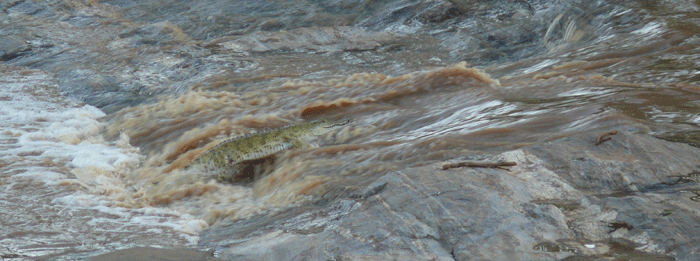
The river was a hive of activity. The Pied Kingfishers had arrived from the Athi, a sure sign that the fish were on their way upriver.
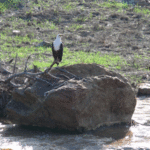
Fish Eagle (click to enlarge)
The Fish Eagle was there too – such a majestic creature. The Village Weavers were unphased by the fact that their Yellow Fever Tree was now surrounded by water: their nest-building frenzy continued unabated. The Chestnut Weavers have arrived too, the males just starting to change their coats and develop their full chestnut breeding plumage. A couple of European Rollers, a Greater Spotted Cuckoo, a Hammerkop, a couple of Bulbuls, a Cordon Bleu pair building a nest, were all among the birds which were flitting around as we sat on our cliff edge, crocodile watching. Another yellow and green bird was being chased by a Starling – it’s back to the bird book on that one.
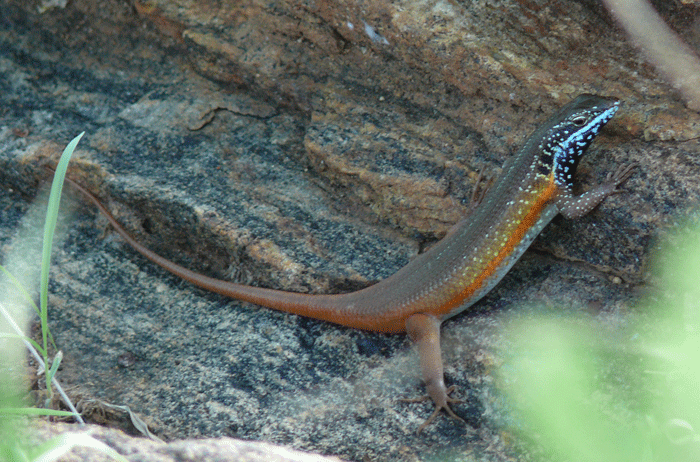

Rainbow skink female
I photographed the fantastically coloured male Rainbow Skink in full breeding regalia, with his striped female who is equally striking in black and white with her electric blue tail. It's a perfect environment for them there, with lots of flat rocks to hide under and no doubt insects aplenty. A male Agama lizard was up there too, displaying at us, bobbing his head up and down and looking at us with great mistrust. When he realised he could not intimidate us, he seemed to give up and quite happily continued his insect-foraging.
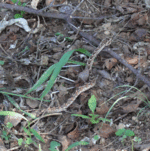
Well-camouflaged baby Puff Adder
We passed a baby Puff Adder on the path – one of Africa’s deadliest snakes. It’s that time of year – with the rain, all the “nasties” come out. We’ve had legions of scorpions in the house over the past few nights. Through the many dry months, we never see them, but as soon as it rains, out they all come. Growing up in the bush in Africa, you learn as a child to watch where you walk, and to always turn on the lights if you get up at night (no padding barefoot across the floor) – just like elsewhere, you learn to look left and right before crossing the road. When you grow up with it, it just becomes second nature.
We heard hyena last night (and saw its tracks on the path too, near the Puff Adder) and tonight the lions are roaring. Can you believe it, we also heard a dog barking! This may not sound strange, but when you consider the fact that we are several miles away from the nearest homestead or village, it is not to be expected. The problem of feral dogs is something that is spreading across East Africa’s national parks – where once domestic dogs have now run wild – just like the dingoes in Australia, I suppose. How the dogs survive with the lions and leopards around, I don’t know – the sound of a barking dog is like a dinner bell to a leopard.
 Tanya
Tanya
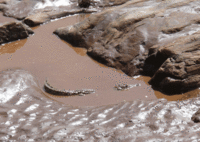
Click on thumbnail to enlarge
I forgot to mention the little crocodile we watched hunting for fish along the edge of the Athi, right below our balcony. It was systematically trawling the river bank, and wherever there was a small inlet, the crocodile would swim into it, and deliberately seemed to block the entrance with its body and tail, so that any fish in the inlet would be trapped there and could not escape. Who says crocodiles can't reason?

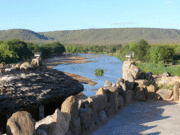
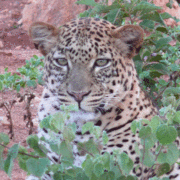
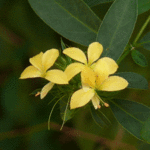

Reader Comments